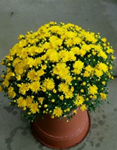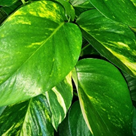By Pat Naughton
Winter is here and that means spending more time indoors. Cabin fever is not the only illness that can come from being cooped up indoors. Volatile organic compounds (VOC’s) are given off from certain solids or liquids and include a variety of chemicals that may have short or long-term health effects. Some of these chemicals found in VOC’s include formaldehyde, benzene, carbon monoxide, xylene, trichloroethylene, and toluene.
They can be found in carpet, furnishings, glues, permanent markers, and building materials. Increasing the ventilation is one method of removing these compounds from the indoors. A natural alternative is to increase the number of indoor plants that remove these compounds.
Here are a few indoor plants that were found effective in removing VOC’s in a study conducted by NASA in 1989.
 Mass Cane (Dracaena fragrans) is also known as corn plant because of the resemblance of the stem to a corn stalk. This plant was found to be the most effective in removing formaldehyde, 70% in a 24-hour period. It likes bright to moderate filter light indoors and does very well in lower light. Keep it away from direct sun since that can burn the foliage.
Mass Cane (Dracaena fragrans) is also known as corn plant because of the resemblance of the stem to a corn stalk. This plant was found to be the most effective in removing formaldehyde, 70% in a 24-hour period. It likes bright to moderate filter light indoors and does very well in lower light. Keep it away from direct sun since that can burn the foliage.
 Gerber daisy (Gerbera jamesonii) was found to remove 67% of benzene in a 24-hour period. In the mild coastal climate of Brunswick County, this plant can be a perennial and brought indoors in the winter. This plant has wonderful long-lasting cut flowers. It prefers moist, well-drained soil rich in organic matter. It should be kept moist and fertilized lightly.
Gerber daisy (Gerbera jamesonii) was found to remove 67% of benzene in a 24-hour period. In the mild coastal climate of Brunswick County, this plant can be a perennial and brought indoors in the winter. This plant has wonderful long-lasting cut flowers. It prefers moist, well-drained soil rich in organic matter. It should be kept moist and fertilized lightly.
 Potted mums (Chrysanthemum) were the most effective in removing trichloroethylene, 41% in a 24-hour period. There are many varieties of mums. Potted mums are not the same as the hardy varieties that go into garden beds. They are more sensitive to cold and light changes, but you can find them any time of the year and bloom for several weeks in the home interior. Growing chrysanthemums indoors is easy and requires little special care beyond watering, good soil and drainage.
Potted mums (Chrysanthemum) were the most effective in removing trichloroethylene, 41% in a 24-hour period. There are many varieties of mums. Potted mums are not the same as the hardy varieties that go into garden beds. They are more sensitive to cold and light changes, but you can find them any time of the year and bloom for several weeks in the home interior. Growing chrysanthemums indoors is easy and requires little special care beyond watering, good soil and drainage.
 One of the most effective choices for eliminating formaldehyde is Golden Pothos (Epipremum Aureum). This ivy type plant has glossy, green or variegated leaves on cascading stems. This plant is very easy to grow indoors. It requires medium light. It can tolerate heavy shade and dry soil. Periodic misting the foliage with water will help increase the humidity. This plant also doubles as an effective eliminator of carbon monoxide as well.
One of the most effective choices for eliminating formaldehyde is Golden Pothos (Epipremum Aureum). This ivy type plant has glossy, green or variegated leaves on cascading stems. This plant is very easy to grow indoors. It requires medium light. It can tolerate heavy shade and dry soil. Periodic misting the foliage with water will help increase the humidity. This plant also doubles as an effective eliminator of carbon monoxide as well.
 Although not mentioned in the NASA study, a Boston Fern (Nepholepis Exaita Bostoniensis) does a great job removing formaldehyde from the air. Its large feathered leaves can span as much as 5 feet. It needs high humidity and moist soil that should never be allowed to dry out. Do not over water. Kitchens and bathrooms are great locations for the higher humidity. Setting on a tray of wet pebbles will also increase the surrounding humidity.
Although not mentioned in the NASA study, a Boston Fern (Nepholepis Exaita Bostoniensis) does a great job removing formaldehyde from the air. Its large feathered leaves can span as much as 5 feet. It needs high humidity and moist soil that should never be allowed to dry out. Do not over water. Kitchens and bathrooms are great locations for the higher humidity. Setting on a tray of wet pebbles will also increase the surrounding humidity.
For more information on houseplants, visit https://www.ces.ncsu.edu/tags/houseplants/
